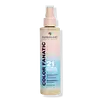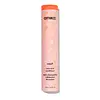What's inside
What's inside
 Key Ingredients
Key Ingredients

No key ingredients
 Benefits
Benefits

 Concerns
Concerns

 Ingredients Side-by-side
Ingredients Side-by-side

Water
Skin ConditioningCocos Nucifera Oil
MaskingAmodimethicone
Polyquaternium-37
PPG-5-Ceteth-10 Phosphate
EmulsifyingPhenoxyethanol
PreservativePropylene Glycol Dicaprylate/Dicaprate
EmollientAcetamide Mea
HumectantSodium Hydroxide
BufferingParfum
MaskingLactamide Mea
HumectantDimethicone
EmollientPPG-1 Trideceth-6
Skin ConditioningButylene Glycol
HumectantTrideceth-6
EmulsifyingBehentrimonium Chloride
PreservativeXylose
HumectantEthylhexylglycerin
Skin ConditioningHelianthus Annuus Seed Extract
Skin ConditioningSorbitan Oleate
EmulsifyingLinalool
PerfumingDimethiconol
EmollientBenzophenone-4
UV AbsorberIsopropyl Alcohol
SolventCetrimonium Chloride
AntimicrobialTocopherol
AntioxidantCamelina Sativa Seed Oil
Skin ConditioningAscorbyl Glucoside
AntioxidantOlea Europaea Fruit Oil
MaskingBenzyl Alcohol
PerfumingGeraniol
PerfumingCitronellol
PerfumingBenzyl Salicylate
PerfumingHydrolyzed Vegetable Protein Pg-Propyl Silanetriol
Skin ConditioningIsoeugenol
PerfumingBHT
AntioxidantMelanin
Skin ProtectingSodium Benzoate
MaskingPentylene Glycol
Skin ConditioningPotassium Sorbate
PreservativeCitric Acid
BufferingWater, Cocos Nucifera Oil, Amodimethicone, Polyquaternium-37, PPG-5-Ceteth-10 Phosphate, Phenoxyethanol, Propylene Glycol Dicaprylate/Dicaprate, Acetamide Mea, Sodium Hydroxide, Parfum, Lactamide Mea, Dimethicone, PPG-1 Trideceth-6, Butylene Glycol, Trideceth-6, Behentrimonium Chloride, Xylose, Ethylhexylglycerin, Helianthus Annuus Seed Extract, Sorbitan Oleate, Linalool, Dimethiconol, Benzophenone-4, Isopropyl Alcohol, Cetrimonium Chloride, Tocopherol, Camelina Sativa Seed Oil, Ascorbyl Glucoside, Olea Europaea Fruit Oil, Benzyl Alcohol, Geraniol, Citronellol, Benzyl Salicylate, Hydrolyzed Vegetable Protein Pg-Propyl Silanetriol, Isoeugenol, BHT, Melanin, Sodium Benzoate, Pentylene Glycol, Potassium Sorbate, Citric Acid
Water
Skin ConditioningCetearyl Alcohol
EmollientGlycerin
HumectantOlea Europaea Fruit Oil
MaskingDicetyldimonium Chloride
EmulsifyingBehentrimonium Methosulfate
Parfum
MaskingDivinyldimethicone/Dimethicone Copolymer
Hippophae Rhamnoides Seed Oil
Skin ProtectingGlycine Soja Oil
EmollientGlycine
BufferingAlanine
MaskingArginine
MaskingAspartic Acid
MaskingHistidine
HumectantIsoleucine
Skin ConditioningPhenylalanine
MaskingProline
Skin ConditioningSerine
MaskingThreonine
Valine
MaskingCetrimonium Chloride
AntimicrobialStearamidopropyl Dimethylamine
EmulsifyingPolyquaternium-37
Guar Hydroxypropyltrimonium Chloride
Skin ConditioningPhenoxyethanol
PreservativeSodium PCA
HumectantSodium Lactate
BufferingIsopropyl Alcohol
SolventPropylene Glycol Dicaprylate/Dicaprate
EmollientCaprylyl Glycol
EmollientPCA
HumectantCitric Acid
BufferingEthylhexylglycerin
Skin ConditioningPPG-1 Trideceth-6
Skin ConditioningHexylene Glycol
EmulsifyingC12-13 Pareth-3
EmulsifyingC12-13 Pareth-23
CleansingDisodium EDTA
Benzophenone-4
UV AbsorberButylphenyl Methylpropional
PerfumingHydroxycitronellal
PerfumingHydroxyisohexyl 3-Cyclohexene Carboxaldehyde
MaskingLimonene
PerfumingWater, Cetearyl Alcohol, Glycerin, Olea Europaea Fruit Oil, Dicetyldimonium Chloride, Behentrimonium Methosulfate, Parfum, Divinyldimethicone/Dimethicone Copolymer, Hippophae Rhamnoides Seed Oil, Glycine Soja Oil, Glycine, Alanine, Arginine, Aspartic Acid, Histidine, Isoleucine, Phenylalanine, Proline, Serine, Threonine, Valine, Cetrimonium Chloride, Stearamidopropyl Dimethylamine, Polyquaternium-37, Guar Hydroxypropyltrimonium Chloride, Phenoxyethanol, Sodium PCA, Sodium Lactate, Isopropyl Alcohol, Propylene Glycol Dicaprylate/Dicaprate, Caprylyl Glycol, PCA, Citric Acid, Ethylhexylglycerin, PPG-1 Trideceth-6, Hexylene Glycol, C12-13 Pareth-3, C12-13 Pareth-23, Disodium EDTA, Benzophenone-4, Butylphenyl Methylpropional, Hydroxycitronellal, Hydroxyisohexyl 3-Cyclohexene Carboxaldehyde, Limonene
 Reviews
Reviews

Ingredients Explained
These ingredients are found in both products.
Ingredients higher up in an ingredient list are typically present in a larger amount.
Benzophenone-4 is a water-soluble chemical sunscreen.
It protects in the UV-B range, but is considered a secondary UV absorber. This means that it needs to be paired with other sunscreen ingredients to provide effective protection.
Typically, it's used in cosmetic products to protect them from deterioration caused by UV rays. This is why you'll find it in a lot of products that aren't sunscreens.
Learn more about Benzophenone-4This ingredient is a preservative, antimicrobial, and emulsifier. It is often used in cosmetics for its ability to cleanse, condition, and reduce static.
Cetrimonium chloride is a quaternary ammonium salt, meaning it has a water-soluble structure.
Citric Acid is an alpha hydroxy acid (AHA) naturally found in citrus fruits like oranges, lemons, and limes.
Like other AHAs, citric acid can exfoliate skin by breaking down the bonds that hold dead skin cells together. This helps reveal smoother and brighter skin underneath.
However, this exfoliating effect only happens at high concentrations (20%) which can be hard to find in cosmetic products.
Due to this, citric acid is usually included in small amounts as a pH adjuster. This helps keep products slightly more acidic and compatible with skin's natural pH.
In skincare formulas, citric acid can:
While it can provide some skin benefits, research shows lactic acid and glycolic acid are generally more effective and less irritating exfoliants.
Most citric acid used in skincare today is made by fermenting sugars (usually from molasses). This synthetic version is identical to the natural citrus form but easier to stabilize and use in formulations.
Read more about some other popular AHA's here:
Learn more about Citric AcidEthylhexylglycerin (we can't pronounce this either) is commonly used as a preservative and skin softener. It is derived from glyceryl.
You might see Ethylhexylglycerin often paired with other preservatives such as phenoxyethanol. Ethylhexylglycerin has been found to increase the effectiveness of these other preservatives.
Isopropyl Alcohol is more commonly known as rubbing alcohol. It is most commonly used as a solvent, meaning it helps other ingredients dissolve.
This ingredient is an astringent alcohol. Astringent alcohols may also irritate skin as they high amounts may strip away your skin's natural oils.
Other types of astringent alcohols include:
According to the National Rosacea Society based in the US, you should be mindful of products with these alcohols in the top half of ingredients.
Any type of sanitizing product will have high amounts of alcohol to help kill bacteria and viruses.
Learn more about Isopropyl AlcoholOlea Europaea Fruit Oil is the fixed oil obtained from the ripe fruit of the Olive. In other words - olive oil.
The primary contents of olive oil are glycerides of the fatty acids linoleic, oleic and palmitic.
Olive oil also contains antioxidants such as Vitamin E. Antioxidants may help reduce signs of aging by fighting unstable free-radical molecules. It also contains Vitamins A (retinol), D, and K.
The squalene in olive oil makes it a great emollient. Emollients help soothe and soften your skin by trapping moisture in. This makes olive oil a great skin moisturizer.
Studies show olive oil to have antibacterial and antifungal properties in low concentrations. Another study found olive oil irritated sensitive oily skin. We always recommend speaking with a professional about using this ingredient in your routine.
Due to the fatty acid content, this ingredient may not be fungal-acne safe.
Learn more about Olea Europaea Fruit OilParfum is a catch-all term for an ingredient or more that is used to give a scent to products.
Also called "fragrance", this ingredient can be a blend of hundreds of chemicals or plant oils. This means every product with "fragrance" or "parfum" in the ingredients list is a different mixture.
For instance, Habanolide is a proprietary trade name for a specific aroma chemical. When used as a fragrance ingredient in cosmetics, most aroma chemicals fall under the broad labeling category of “FRAGRANCE” or “PARFUM” according to EU and US regulations.
The term 'parfum' or 'fragrance' is not regulated in many countries. In many cases, it is up to the brand to define this term.
For instance, many brands choose to label themselves as "fragrance-free" because they are not using synthetic fragrances. However, their products may still contain ingredients such as essential oils that are considered a fragrance by INCI standards.
One example is Calendula flower extract. Calendula is an essential oil that still imparts a scent or 'fragrance'.
Depending on the blend, the ingredients in the mixture can cause allergies and sensitivities on the skin. Some ingredients that are known EU allergens include linalool and citronellol.
Parfum can also be used to mask or cover an unpleasant scent.
The bottom line is: not all fragrances/parfum/ingredients are created equally. If you are worried about fragrances, we recommend taking a closer look at an ingredient. And of course, we always recommend speaking with a professional.
Learn more about ParfumPhenoxyethanol is a preservative that has germicide, antimicrobial, and aromatic properties. Studies show that phenoxyethanol can prevent microbial growth. By itself, it has a scent that is similar to that of a rose.
It's often used in formulations along with Caprylyl Glycol to preserve the shelf life of products.
We don't have a description for Polyquaternium-37 yet.
We don't have a description for PPG-1 Trideceth-6 yet.
Propylene Glycol Dicaprylate/Dicaprate is a mixture of Propylene Glycol Dicaprylate and Propylene Glycol Dicaprate.
It is an emollient and helps hydate the skin.
Water. It's the most common cosmetic ingredient of all. You'll usually see it at the top of ingredient lists, meaning that it makes up the largest part of the product.
So why is it so popular? Water most often acts as a solvent - this means that it helps dissolve other ingredients into the formulation.
You'll also recognize water as that liquid we all need to stay alive. If you see this, drink a glass of water. Stay hydrated!
Learn more about Water